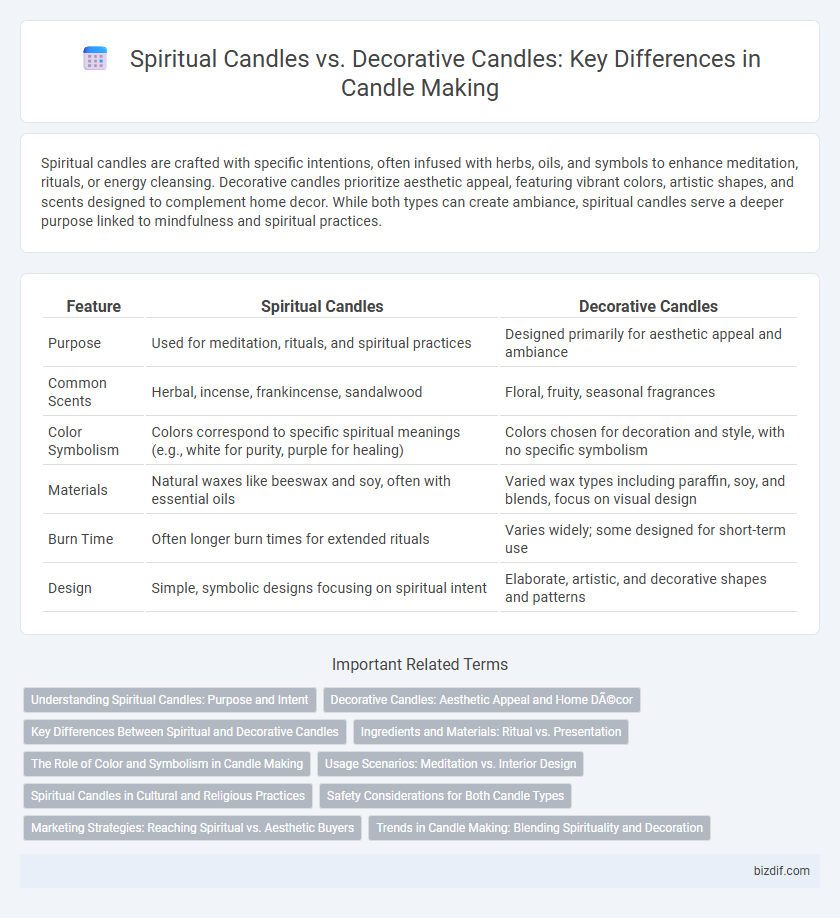Spiritual candles are crafted with specific intentions, often infused with herbs, oils, and symbols to enhance meditation, rituals, or energy cleansing. Decorative candles prioritize aesthetic appeal, featuring vibrant colors, artistic shapes, and scents designed to complement home decor. While both types can create ambiance, spiritual candles serve a deeper purpose linked to mindfulness and spiritual practices.
Table of Comparison
| Feature | Spiritual Candles | Decorative Candles |
|---|---|---|
| Purpose | Used for meditation, rituals, and spiritual practices | Designed primarily for aesthetic appeal and ambiance |
| Common Scents | Herbal, incense, frankincense, sandalwood | Floral, fruity, seasonal fragrances |
| Color Symbolism | Colors correspond to specific spiritual meanings (e.g., white for purity, purple for healing) | Colors chosen for decoration and style, with no specific symbolism |
| Materials | Natural waxes like beeswax and soy, often with essential oils | Varied wax types including paraffin, soy, and blends, focus on visual design |
| Burn Time | Often longer burn times for extended rituals | Varies widely; some designed for short-term use |
| Design | Simple, symbolic designs focusing on spiritual intent | Elaborate, artistic, and decorative shapes and patterns |
Understanding Spiritual Candles: Purpose and Intent
Spiritual candles serve a specific purpose in rituals, meditation, and prayer, often infused with symbolic meanings, scents, and colors to enhance spiritual practices. Unlike decorative candles designed for ambiance or aesthetic appeal, spiritual candles are intentionally crafted to focus energy, invoke intentions, or honor deities and spirits. Their significance lies in the mindful use of flame and symbolism to support personal growth, healing, and connection to the divine.
Decorative Candles: Aesthetic Appeal and Home Décor
Decorative candles enhance home decor by adding color, texture, and ambiance to any space, often designed with intricate shapes, patterns, and scents to complement interior styles. Unlike spiritual candles, which are primarily used for rituals and symbolic purposes, decorative candles serve as stylish accents that create warmth and visual interest. Their diverse designs and soothing glow make them ideal for elevating the aesthetic appeal of living rooms, bedrooms, and dining areas.
Key Differences Between Spiritual and Decorative Candles
Spiritual candles are designed for rituals, meditation, and intention setting, often infused with specific scents, colors, and symbols to enhance spiritual practices. Decorative candles prioritize aesthetic appeal, focusing on shapes, colors, and designs to complement home decor without specific ritualistic functions. The key differences lie in their purpose, ingredients, and symbolic meanings, with spiritual candles serving a functional role in ceremonies and decorative candles enhancing visual ambiance.
Ingredients and Materials: Ritual vs. Presentation
Spiritual candles often use natural ingredients such as beeswax, soy wax, or palm wax, combined with essential oils and herbs to enhance ritualistic intentions and energetic properties. Decorative candles prioritize aesthetics, typically crafted from paraffin wax or blended waxes and incorporate synthetic fragrances and vibrant dyes for visual appeal. The choice of materials directly impacts the candle's burn quality, scent diffusion, and symbolic significance in spiritual versus ornamental use.
The Role of Color and Symbolism in Candle Making
In candle making, spiritual candles utilize specific colors to evoke particular energies and intentions, such as blue for peace, red for passion, and green for healing, deeply rooted in cultural and spiritual symbolism. Decorative candles prioritize aesthetic appeal, often featuring vibrant or pastel colors that complement interior decor rather than conveying spiritual meanings. The choice of color in spiritual candles serves as a powerful tool for meditation and ritual, while in decorative candles, it enhances visual ambiance and design.
Usage Scenarios: Meditation vs. Interior Design
Spiritual candles are primarily used in meditation and ritual practices to create a calming atmosphere and enhance focus through symbolic colors and scents. Decorative candles serve as aesthetic elements in interior design, adding ambiance and style to living spaces with varied shapes, colors, and fragrances. Meditation settings benefit from spiritual candles' intention-driven properties, while interior design utilizes decorative candles to complement room themes and elevate decor.
Spiritual Candles in Cultural and Religious Practices
Spiritual candles hold significant roles in cultural and religious practices, symbolizing faith, hope, and spiritual connection during rituals and ceremonies. These candles often feature specific colors, scents, and symbols aligned with traditions such as Christianity, Buddhism, and Paganism, enhancing meditation, prayer, and intention-setting. Unlike decorative candles, spiritual candles serve as sacred tools designed to invoke protection, healing, and divine presence.
Safety Considerations for Both Candle Types
Spiritual candles often use simpler materials like beeswax or soy, which burn cleaner and release fewer toxins, reducing indoor air pollution risks compared to decorative candles that may contain synthetic fragrances and paraffin wax. Both candle types require placement away from flammable objects and surfaces, with supervision during burning to prevent accidental fires. Proper extinguishing methods, such as using a snuffer instead of blowing out, minimize wax splatter and smoke, enhancing safety for spiritual and decorative candle use alike.
Marketing Strategies: Reaching Spiritual vs. Aesthetic Buyers
Marketing strategies for spiritual candles prioritize targeting buyers through channels emphasizing mindfulness, healing, and ritualistic use, leveraging platforms such as wellness blogs, meditation apps, and holistic lifestyle influencers. In contrast, decorative candles are promoted via home decor magazines, interior design social media pages, and seasonal trend campaigns, focusing on aesthetic appeal and ambiance enhancement. Tailoring messaging to highlight spiritual benefits versus design elements ensures precise engagement with either spiritually motivated or aesthetically driven consumers.
Trends in Candle Making: Blending Spirituality and Decoration
Spiritual candles often feature scents and colors aligned with meditation, healing, and rituals, enhancing their symbolic and therapeutic value in candle making. Decorative candles emphasize aesthetic appeal, incorporating unique shapes, textures, and vibrant hues to complement home decor, reflecting the growing trend of blending functionality with artistry. The current candle making market sees a fusion of these elements, with consumers seeking candles that offer both spiritual meaning and decorative charm, highlighting an evolving preference for multi-purpose candle designs.
Spiritual candles vs Decorative candles Infographic

 bizdif.com
bizdif.com